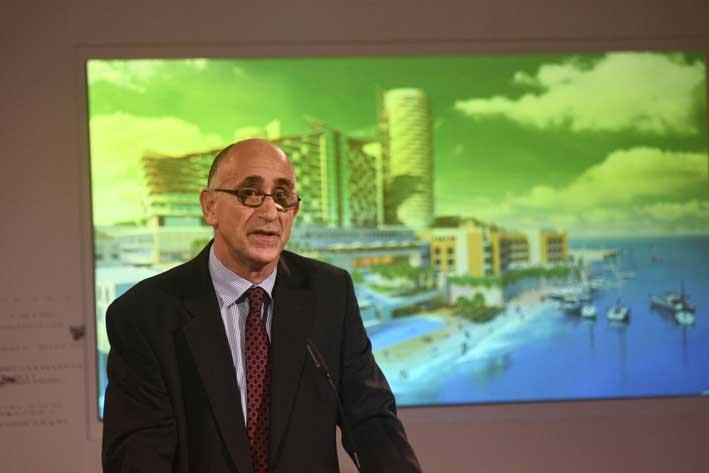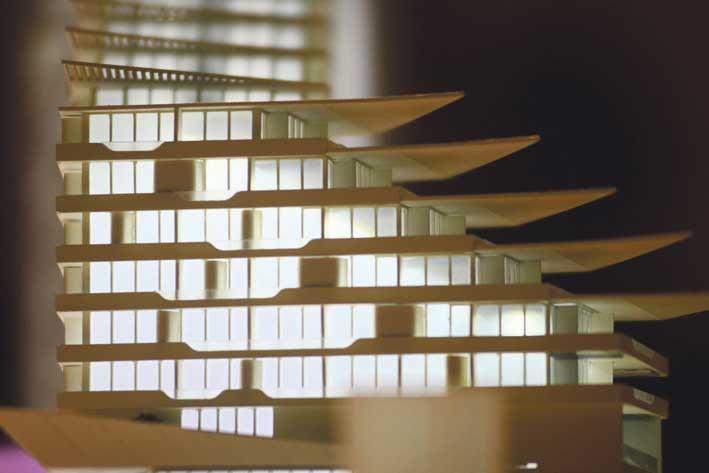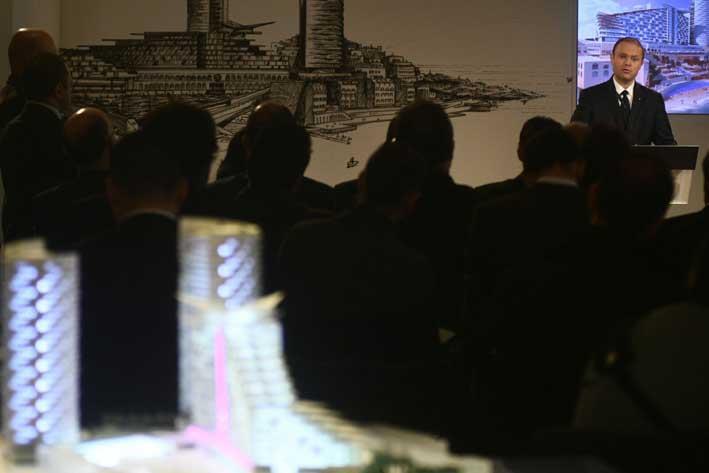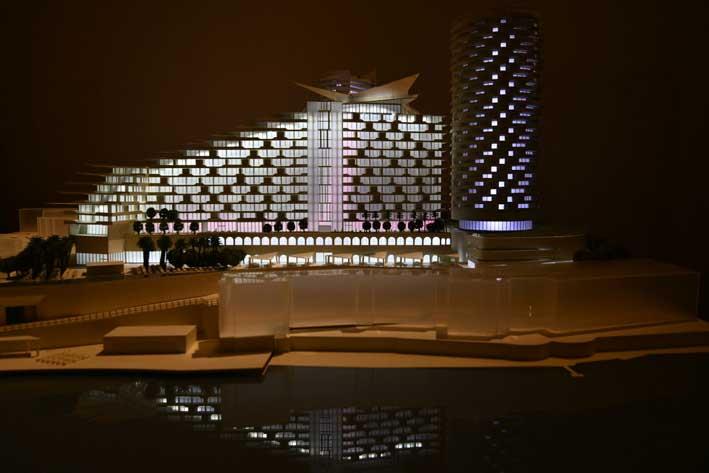Arthur Gauci, the CEO of the db Group, has defended the €60 million valuation of the ITS site deal signed earlier this week, following a number of arguments made that the draft Paceville master plan had valued the site at a higher price.
Earlier this week, the government signed a 99-year temporary emphyteusis with db San Gorg Property Ltd for the current ITS site, and during the press conference it was stated that the government will receive nearly €60 million in return. The project includes the building of a hotel, a commercial centre, and two towers primarily consisting of residential units, with a few floors dedicated to office space. The project still needs to go before the Planning Authority.
It was the Partit Demokratiku (led by Marlene Farrugia) who questioned the price soon after the deal was signed, stating that the group was paying much less than what the land is worth, and that the master plan valued the site at €8,500 per square metre. The value of the deal was criticised further yesterday (See page 2).
Mr Gauci said the developers would have been more than happy to pay the €8,500 per square metre benchmark, claiming that this price was for “the real estate component and not the hotel development”. The €8,500 per square metre for the 2,000 square metre real estate component of the development, he said, would amount to €17 million.

“I would have been more than happy to have that valuation done on our project, and then have the government charge us the ground rent on the hotel similar to that of other hotels in the area. I would have been happy to pay the ground rent other hotels are paying and then pay the 8,500 per square metre for the real estate.
“It would have been a much better deal for us.”
Discussing the idea of paying €8,500 per square metre, he said that in the “registration of interests we issued, the figure we are trying to sell (the residential component) is nowhere near €8,500 per square metre. How can we buy land at €8,500 per square metre when the market shows this not a price at which we can sell? We are selling them at much less.”
This newsroom said that even if one takes €8,500 per square metre as being for the real estate component, they would still need to pay the same price they are paying now for the other components, such as the hotel.
“The government adopted a new formula after consultation with Deloitte, and we have been the guinea pigs in all this. The government has never used this formula before. Some salient points about the formula are that we have a temporary land concession for 99 years, and the government retained the right to make us pay more if, once we go to planning and build up even one square metre more than what we presented here. Therefore, for 99 years, our price will continue fluctuating. Name a contract where this has ever happened in Malta.”

“Not only did we pay a fair price for the land following professional valuations by Deloitte, our valuation submission was less than that, although the numbers mentioned in the media were incorrect.”
He said that during the tender submission process, the db Group did not come up with a price off the top of its head, but had conducted an analysis of similar contracts which past governments gave on similar developments, using them as a benchmark, as well as considering other projects.
Mr Gauci described the agreed price (€60 million) per square metre as the highest seen, when compared to all other similar developments.
“When you see statements like the one issued by the Partit Demokratiku, you feel frustrated, as they have not quite grasped how the valuation was made. I wish we could sell the residential units within the towers for the amounts they mentioned.
“You cannot apply that amount (€8,500 per square metre) to a hotel development as well, as you will never get those kinds of returns. In total, we are paying more than what was paid for other hotels, including those in the vicinity and for other property developments in general.”
What was your original valuation?
That’s water under the bridge. It was lower; we had made our own calculations at the time. We sat down with the government who had their own ideas and we had to see whether what the government was proposing was feasible or not. Since then, we have had the benefit of testing the market in terms of real estate, and where we were able to fluctuate, we did.

There were allegations which had appeared in the press that the request for proposals issued by government was designed to favour your group’s proposal? Is this true?
For one to assume that the request for proposals was designed for our proposal is fallacious. Our original idea for the site did not include any real estate or a shopping mall. The development was much smaller than what was eventually submitted. Our initial thought was to have a good five-star hotel in the locality.
If it was true that the request for proposals was designed to favour us then criminal proceedings could be taken. When the request for proposals was issued, we hit the ground running, engaging a number of international architects to submit proposals based on the request. We submitted three proposals, not just one design, in our submission. Eventually the current design was chosen.
How could the request for proposals have favoured us when our original idea was just for a hotel? We had to rehash everything to comply with the request for proposals.
You previously said that you spoke with both the government and the Opposition prior to the election...
We speak to whoever is in government at the time. One has to constantly speak with stakeholders if you want to move forward. Ultimately, the government is a stakeholder in a number of ways, with everyone. Government is even a stakeholder with employees, as it takes 10 per cent of their salary for National Insurance, aside from income tax. Government is a stakeholder with everyone, let alone with business people who are creating jobs in a variety of ways.
How can you not speak with the government about proposals you have on your mind. I can think of nine or ten separate project proposals (nothing to do with this) which we have spoken to government about, where both this government and the previous administration had different ideas. It does not mean that because we speak with the government, it is automatically on-board. In one of the first meetings we had with Prime Minister Joseph Muscat, we gave him nine proposals for Mellieha. Sadly, nothing has happened to this day. You have to speak to the government, no man is an island.

Did you donate to the PN or the PL prior to the 2013 general election?
Over the years we have occasionally given minor donations, not of any material amounts [Mr Gauci would not settle on providing numbers but stressed that they were small amounts].
During the press conference announcing the launch, it was said that you will invest €300 million in the project. How will you finance this?
The project will be financed through a number of different sources. We did not limit ourselves to Malta. When I was in discussions with bankers in London, it became apparent that this would be considered a big project even for the city of London itself. When it comes to such huge projects, banks do not usually finance such projects in their entirety. This is not a €5-€10 million development which is usually financed through conventional means – going to a bank, putting in some seed capital with the rest coming from the bank.
There are a number of instruments which can be used to finance a project like this. The options we have looked at include syndicated bank facility, where one goes to a number of banks who put the money into one pot, so to say, and that facility will be made available to you. No bank in Malta has the capability of financing such a project on its own.
We also plan to go forward with a public bond issue, and we have already spoken to a number of financial intermediaries for their feedback on liquidity and insight into what the market is like. The feedback was positive. We, of course, will also put in funds. The shopping mall is also a joint venture, so if, for example, it would cost €25 million to develop, we wouldn’t need to make funds available ourselves. For the residential towers, the residential units will be finished in terms of tiles, air-conditioning, and so on, but would not be furnished. That will be handled by people moving in. Therefore, the investment will come through a combination. It is very complex and is not as straightforward as I am putting it.
We would never have gone for this commitment had we not had the backing from the banks and the financial intermediaries.
How was the total estimated commercial consideration of €60 million calculated?
The ground rent that needs to be paid is €1.56 million. This will rise according to the retail price index every five years. For the first five years there is an abatement, where government is giving the concession for €1,000 per annum instead of the €1.56 million in order to allow us to develop the land etc…, which is normal.
This emphyteutical concession is also made in consideration of a total contribution made by the company to the Government of Malta. €5 million was paid on the signing of the contract, and we also paid nearly €3 million by way of stamp duty. €10 million will be paid in seven annual instalments.
There is also the transfer of emphyteusis from temporary to perpetual, for the residential units, office units and garages, which would cost €33 per square metre for the garage space and €167 per square metre for the rest, which will amount to €6.5 million for the residential development. The rates of these payments will depend on when the owners of the residential units would want to change to a perpetual emphyteusis.
There is also the redemption from perpetual to freehold, where the payment must be €31.72, multiplied by the amount of footprint being converted, multiplied by 20. So if you have an apartment of 200 square metres, you multiply that by €31.72 and multiply by 20, to determine the amount you need to redeem it.
This will amount, in total for the residential development, to €23.4 million.
Over the duration of the lease, we will pay a total of €11.2 million in ground rent, capitalised at the rate of 3.5%. This is also with regards to the hotel Ground Rent, the Mall Ground Rent and the nonredeemable portion of the Car Park Ground Rent.

You have signed the contract with the government, yet the master plan has not been finalised. The master plan was discussed over a number of months, and was debated in Parliament. Don’t you think signing this agreement with the government is unfair to those people who spent time submitting their ideas on the proposals and criticising the plan?
The government issued a tender. Once the government issues a tender, it cannot budge from the parameters of that tender. Irrespective of what the master plan may or may not include, we could only sign with government, and government can only sign with us, on what was in the tender. If the government changed one per cent of the goal post, it would have to go back to the tendering procedure. Irrespective of the master plan, that was the only option. It can change but they would have to go back to tender.
As stated by the Parliamentary Secretary for Lands Deborah Schembri, just because there is a master plan in the offing, does not mean that all development in the area would need to stop. We signed on what was in the tender and we have to submit our plans according to the current planning laws. If eventually the master plan allows us to do more, then it is clear that we would have to pay more to build more.
The master plan which was presented to the public showed more than the two towers in your plan. Would you want to build more towers or are you satisfied with what you have now?
It showed four high-rise buildings to be honest. We submitted our comments on the master plan, and the master plan proposing four towers, does not work. One reason it doesn’t work, in our opinion, is that Malta is not London or New York. People don’t go to London to enjoy a view; they go there because they enjoy the vibe, the aura, being in London or New York. Malta is a different kettle of fish, and we cannot compete with those kinds of destinations. We can never replicate London in Malta. We need to have a resort hotel element. The bulk of the top four- or five-star hotels in Malta all offer large pools or beach access. This is the environment we operate in. You cannot have a resort hotel and then suffocate me by building all around me, it does not work. You need the open space. You cannot for example, give me 142,000 square metres of land, and allow me to build on 5,000 square metres and go as high as I want. It will not work.

Will you be renting or selling the apartments?
In the contract we have the right to sell them, and that is our intention. The average price we are currently selling them at and I can say that we have had quite a number of registrations of interest, is around €4,800 per square metre. The price varies depending on the floor.
Why the Hard Rock franchise as opposed to others?
As you know, we have been associated with the Hard Rock brand in Malta for the past 16 years. This does not mean that the Hard Rock hotels were an automatic choice. We looked into a number of brands before choosing the Hard Rock one. We conducted our evaluations and we believe that the Hard Rock hotel was more aligned with our vision.
We have some good five-star hotels in Malta, but we wanted to go for a new niche market in the five-star category which does not currently exist in Malta.
You can go to a Hard Rock hotel and you can still attend a conference in a jacket and tie. As soon as you enter the lobby, you get this certain vibe, and it’s in the little details like the bands playing, or the ring-tone you get for a wake-up call, the kind of spa music and so on. The idea is to combine fun while still providing the level of quality discerning tourists expect and pay for.
Our idea is to have three components in one hotel. Part of it will be family orientated, for families with children, another section will be for adults (like honeymooners and tourists who do not want children running around), and then we will have a number of top-end suites which are nearly on the six-star level. Some of the high-end clients from, for example, the Middle East do not yet view Malta as one of the destinations, as Malta doesn’t yet reach their expectations in terms of quality.
As for facilities, there will be a number of eateries, some of which will include world-renowned names aside from the Hard Rock brand, which are top standards. Since we have not yet signed the deals, I cannot divulge their names yet. There will also be a sky bar at the top of the hotel, with fantastic views of the bay. We will have a state of the art rock spa, a gym for which we have some innovative ideas (such as having a live DJ), conference facilities, both indoor and outdoor pools with different areas designated for children, and so on.

What is the total developable floor space?
The number we gave during the press conference was 140,000, which is correct, but this was the number given for the gross floor area as defined by the Planning Authority, which take into account from the street level upwards. Below street level, we will have the shopping mall, parking etc, which is around another 70,000 square metres more. The total development will, in total, be 202,000 square metres. The car park will have around 2,400 car spaces, which is in excess of the planning authority formula requirements. We will develop around 46 per cent of the footprint; the rest will be open spaces, some of which will be public open spaces.
I believe the contract allows you to bring in a third party to have a share in the commercial centre; do you have anyone in mind?
That’s right. There is a partner already. In fact, the contract specifically mentions with whom we can conduct the deal. We had told government that we wanted these persons to be our partners for the commercial centre. We wanted a partner as we don’t operate any shopping malls on the island. The partners are the Gauci brothers, of Big Ben.
Are the road networks sufficient for the construction and operational phases of the project?
Like any other development, it will be subject to a number of reports and studies, one of which will be the Traffic Impact Statement. In our submission, we gave some proposals on how the network can operate to avoid affecting the already congested Paceville area. When we submit our proposals to the Planning Authority, we will go into more detail, but I can assure you that we have alternative plans other than going through the main Paceville route.
The good thing is that our development is on the periphery, and not in the centre of Paceville, and so we have more options.
I would be presumptuous to say road blockages within the vicinity of the site during construction will not happen, but we will take all mitigation measures. We have to respect our neighbours and the surrounding business community. Part of our detailed plans is to ensure this will cause the least inconvenience possible and the possibility of using unconventional routes.